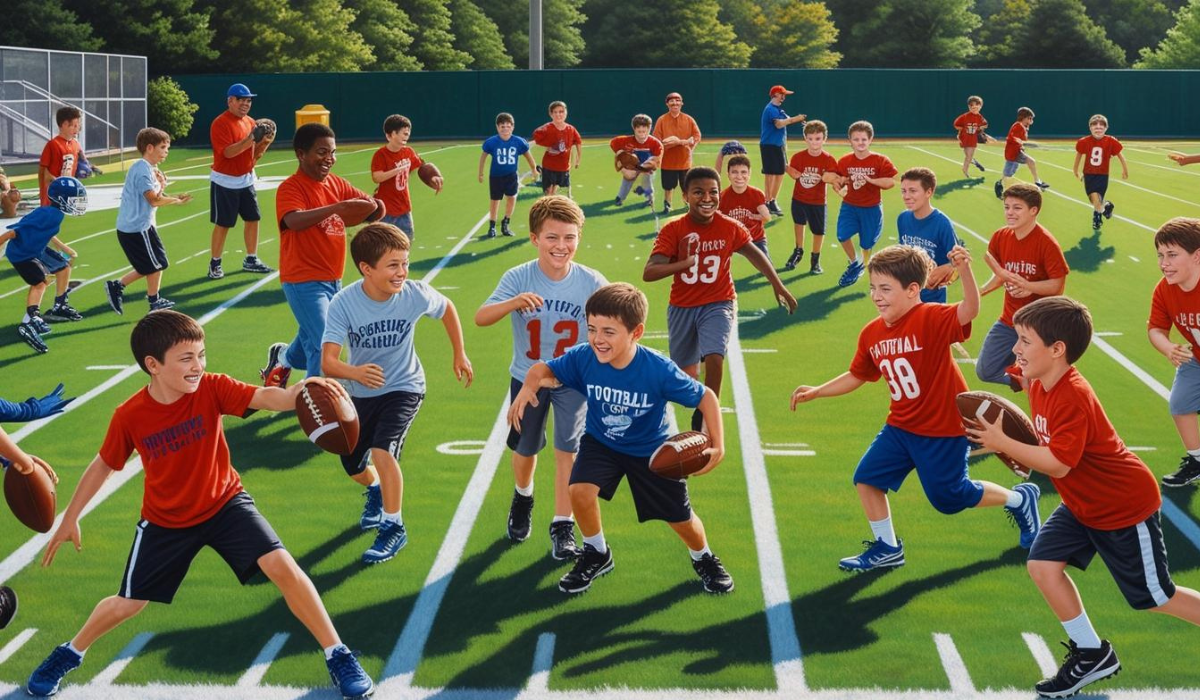Coaching a 10U (10 and under) football team is one of the most fulfilling and challenging roles in youth sports. At this level, the goal isn’t just about winning games but fostering a love for the sport, building fundamental skills, and teaching teamwork.
Whether you’re a new coach or a seasoned one looking to refine your approach, this guide will equip you with everything you need to make the most of your 10U Football Dortey coaching experience. From essential skill-building to effective practice planning and safety considerations, we’ve got you covered.
By the end of this article, you’ll feel confident in guiding your 10U players and ensuring they grow both on and off the field.
What Is 10U Football Dorsey?
Before we dive in, let’s clarify what “10U football dortey” refers to. “10U” means players who are 10 years old and under, which typically means these are novice athletes just beginning to master the fundamentals of football. “Dortey” is often a playful term associated with the grit, determination, and scrappy nature these young players bring to the game, which is a perfect nod to their developing competitive spirit.
The focus at this age is less on advanced tactics and more on fundamentals, fun, and safety.
Now, let’s jump into how to approach coaching this exciting age group.
Fundamental Skills Development
At the 10U level, focusing on the basics is key to building players’ confidence and abilities. Here are the most crucial skills to emphasize, along with drills to help players master them.
Passing and Catching
Effective passing and catching are the foundation of any strong football team. At this age, it’s essential to teach proper throwing mechanics and catching techniques.
- Drill Example: Mirror Dodge Drill. Players stand with a partner, practicing step-and-throw motion, while the receiver mirrors their movements and works on proper hand placement for catching.
Tackling and Blocking
Tackling is a contact-heavy skill, so safety and correct form are paramount. Blocking, on the other hand, helps players work together to protect the ball carrier.
- Drill Example: Kneeling Tackle Drill. Players practice tackling while starting in a kneeling position, ensuring they focus on keeping their heads up and maintaining proper form.
Running with the Ball
Teaching players how to run effectively while protecting the ball can drastically improve their on-field performance.
- Drill Example: Zig Zag Drill. Mark a zigzag path on the field using cones, and have players weave through them while holding the ball securely. This improves agility, ball control, and footwork.
By focusing on these fundamentals, you’ll ensure every player is equipped with the building blocks for success.
Effective Practice Planning
A well-structured practice keeps players engaged and ensures consistent improvement. Here’s how to design an efficient session.
Warm-Up and Conditioning
Begin practice with dynamic stretches and light exercises like jogging or high knees. These not only prepare players physically but also help them mentally transition into practice mode.
Skill Stations
Divide players into small groups and set up skill-specific stations: one for passing, one for blocking, etc. This ensures every child gets focused attention and plenty of repetitions.
- Rotate groups every 10-15 minutes to keep things fresh and engaging.
Small-Sided Games
Small-sided games, like 3-on-3 scrimmages, simulate real-game scenarios while giving all players a chance to shine.
- Encourage teamwork and creative problem-solving as players decide how to maneuver on their own.
A mix of skill-building drills and fun scrimmages will make practice sessions enjoyable and impactful.
Coaching Strategies
An effective 10U coach is more than a trainer. They’re a mentor, motivator, and team builder.
Positive Reinforcement
Celebrate your players’ successes, no matter how small. Whether it’s nailing a pass or hustling during a drill, use positive feedback to build your confidence.
- Example phrasing: “Great effort, Jackson! Keep that up!”
Simplified Playbooks
Avoid overwhelming young players with complex plays. Stick to a few fundamental plays that are easy to understand and execute.
- Focus on one or two running plays and one passing play to start.
Parental Involvement
Keep parents informed and engaged by holding regular meetings to discuss team goals. You can also encourage them to volunteer during practices.
- A supportive sideline can make all the difference for a young athlete.
Safety Considerations
Ensuring every player’s safety should always be your top priority.
Proper Equipment
Ensure all players have well-fitted helmets, pads, and mouthguards. Ill-fitting gear can lead to injuries.
Hydration and Breaks
Kids can tire quickly, especially on hot days. Schedule regular hydration breaks to keep them focused and safe.
Concussion Awareness
Educate yourself and your team about the symptoms of concussions. If a player shows any signs, remove them from play immediately and consult a medical professional.
Your proactive approach to safety will set the tone for a protective and caring coaching environment.
Resources for Coaches
Being a great coach isn’t about knowing everything. It’s about constantly learning and improving. Here are some resources to level up your coaching game.
- Online Resources: Websites like Youth Football Online offer an array of drills and expert tips.
- Coaching Clinics: Attend local or virtual clinics to learn best practices and network with other youth coaches.
- Instructional Videos: Platforms like YouTube host tutorials for beginners, such as “How to Coach Youth Football.”
Leverage these resources to keep your coaching strategies fresh.
FAQ About 10U Football Dortey
What’s the one skill all 10U players should master?
At the 10U level, tackling safely and correctly is a top priority. It helps build confidence while preventing injuries.
How long should 10U football practices last?
Aim for 60-90 minutes, balancing drills, scrimmages, and breaks. This keeps practices productive without overwhelming young players.
Can parents help coach?
Absolutely! Parents often make great assistant coaches or can help with logistics, such as organizing equipment or ensuring hydration.
What’s the ideal roster size for a 10U team?
Typically, 15–25 players work best to ensure everyone gets ample playing time without leaving key positions understaffed.
Shaping Future Football Stars
Coaching a 10U football story isn’t just about teaching sports. It’s about shaping young athletes into confident, capable individuals. By focusing on fundamental skills, fostering a supportive team environment, and prioritizing safety, you create an experience your players will cherish for years to come.

